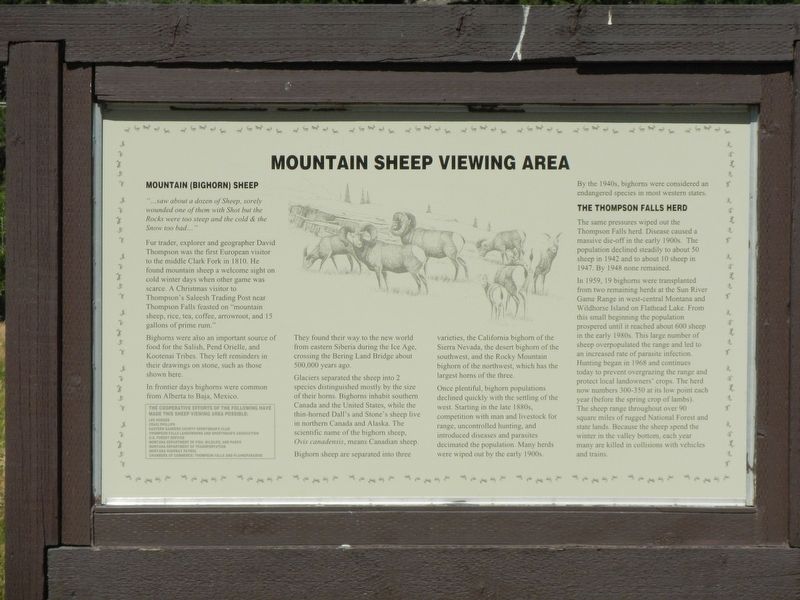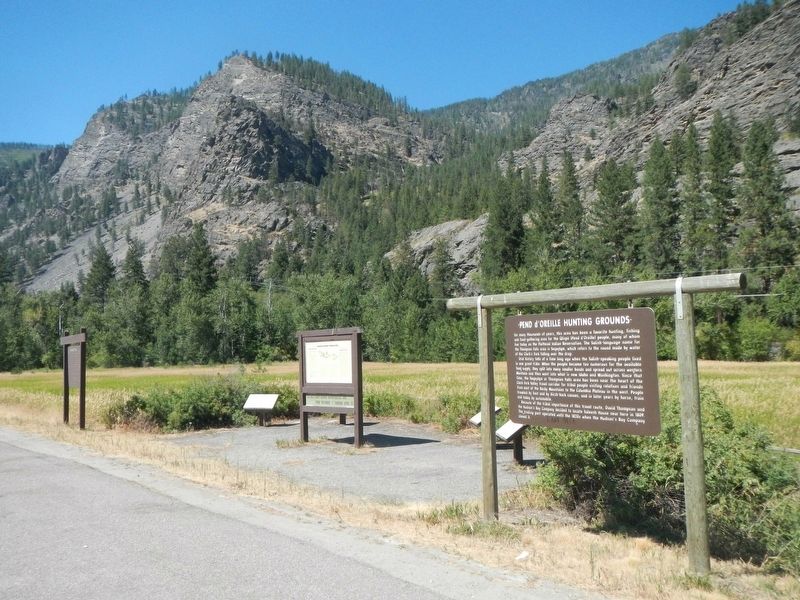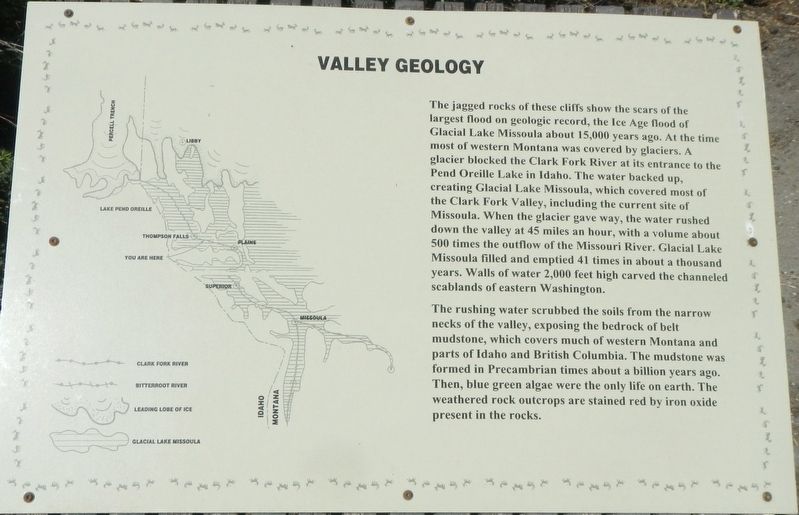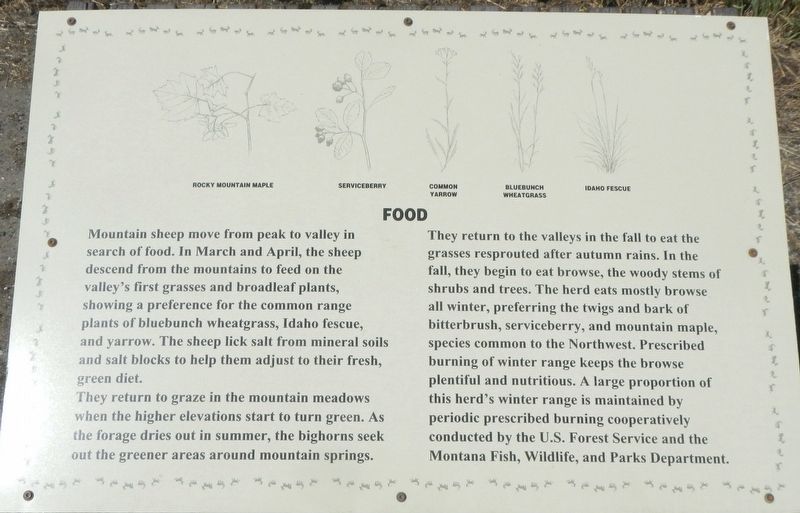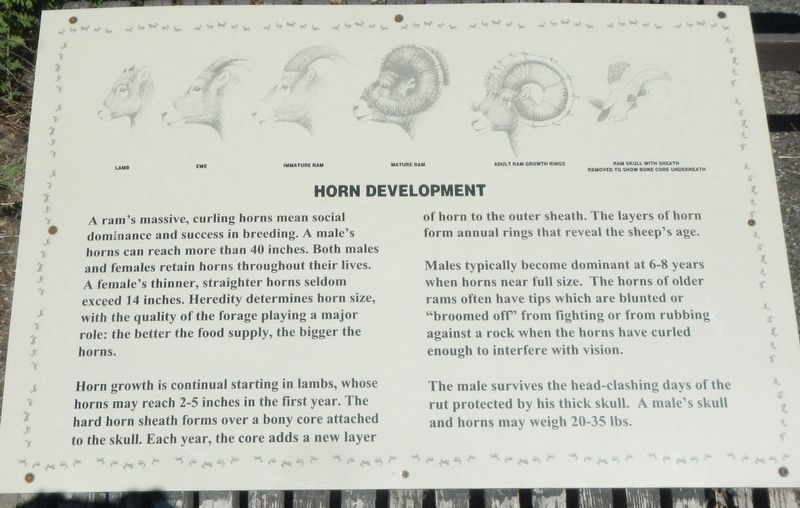Thompson Falls in Sanders County, Montana — The American West (Mountains)
Mountain (Bighorn) Sheep
Fur trader, explorer and geographer David Thompson was the first European visitor to the middle Clark Fork in 1810. He found mountain sheep a welcome sight on cold winter days when other game was scarce. A Christmas visitor to Thompson's Saleesh Trading Post near Thompson Falls feasted on "mountain sheep, rice, tea, coffee, arrowroot, and 15 gallons of prime rum."
Bighorns were also an important source of food for the Salish, Pend Orielle, and Kootenai Tribes. They left reminders in their drawings on stone, such as those shown here (see images around the perimeter) .
In frontier days bighorns were common from Alberta to Baja, Mexico. They found their way to the new world form eastern Siberia during the Ice Age, crossing the Bering Land Bridge about 500,000 years ago.
Glaciers separated the sheep into 2 species distinguished mostly by the size of their horns. Bighorns inhabit southern Canada and the United States, while the thin-horned Dall's and Stone's sheep live in northern Canada and Alaska. The scientific name of the bighorn sheep, Ovis, canadensis, means Canadian sheep.
Bighorn sheep are separated into three varieties, the California bighorn of the Sierra Nevada, the desert bighorn of the southwest, and the Rocky Mountain bighorn of the northwest, which has the largest horns of the three.
Once plentiful, bighorn populations declined quickly with the settling of the west. Starting in the late 1880s, competition with man and livestock for range, uncontrolled hunting, and introduced diseases and parasites decimated the population. Many herds were wiped out by the early 1900s. By the 1940s, bighorns were considered an endangered species in most western states.
The Thompson Herd
The same pressures wiped out the Thompson Falls herd, Disease caused a massive die-off in the early 1900s. The population declined steadily to about 50 sheep in 1942 and to about 10 sheep in 1947. By 1948 none remained.
In 1959, 19 bighorns were transplanted from two remaining herds at the Sun River Game Range in west-central Montana and Wildhorse Island on Flathead Lake. From this small beginning the population prospered until it reached about 600 sheep in the early 1980s. This large number of sheep overpopulated the range and led to an increased rate of parasite infection. Hunting began in 1968 and continues today to prevent overgrazing the range and protect local landowner's crops. The herd now numbers 300-359 at is low point each year (before the spring crop of lambs.). The sheep range throughout over 90
square miles of rugged National Forest and state lands. Because the sheep spend the winter in the valley bottom, each year many are killed in collisions with vehicles and trains.
Topics. This historical marker is listed in this topic list: Animals.
Location. 47° 34.563′ N, 115° 10.312′ W. Marker is in Thompson Falls, Montana, in Sanders County. Marker is on State Highway 200 at milepost 59 near Fruitland Lane, on the right when traveling west. Touch for map. Marker is in this post office area: Thompson Falls MT 59873, United States of America. Touch for directions.
Other nearby markers. At least 8 other markers are within 9 miles of this marker, measured as the crow flies. Pend d'Oreille Hunting Grounds (here, next to this marker); Bad Rock Trail (here, next to this marker); Saleesh House (approx. 7.2 miles away); Road to the Buffalo (approx. 7.2 miles away); David Thompson (approx. 7.2 miles away); Fort Thompson Playground (approx. 8.1 miles away); Weber's Store (approx. 8.1 miles away); Bedard House (approx. 8.3 miles away). Touch for a list and map of all markers in Thompson Falls.
Also see . . . Bighorn Sheep -- National Wildlife Federation. Large, curved horns—borne by the males, or rams—can weigh up to 30 pounds (14 kilograms), as much as the rest of the bones in the male's body. Older rams have massive horns that can grow over three feet (0.9
meters) long with a more than one-foot (0.3-meter) circumference at the base. Females, or ewes, also have horns, but they are short with only a slight curvature. Both rams and ewes use their horns as tools for eating and fighting. (Submitted on April 1, 2023, by Barry Swackhamer of Brentwood, California.)
Credits. This page was last revised on April 1, 2023. It was originally submitted on April 1, 2023, by Barry Swackhamer of Brentwood, California. This page has been viewed 62 times since then and 7 times this year. Photos: 1, 2, 3, 4, 5, 6. submitted on April 1, 2023, by Barry Swackhamer of Brentwood, California.
